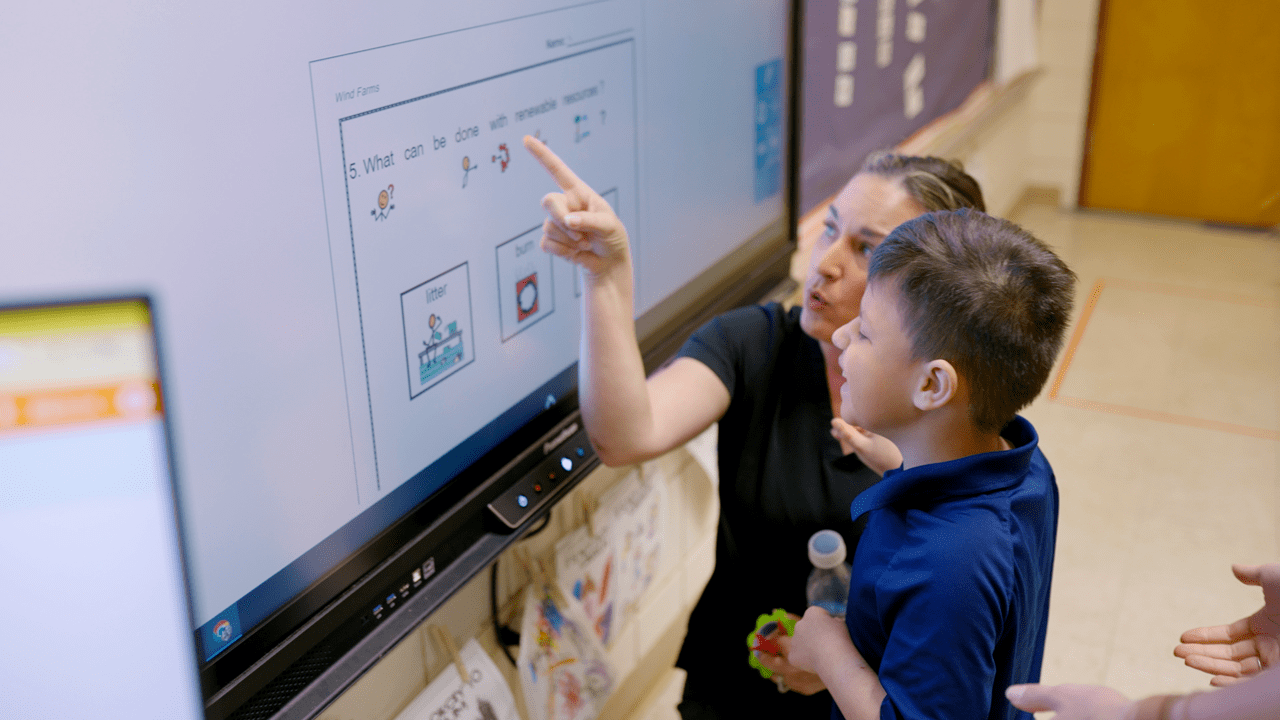Assess expressive vs. receptive skills
When students are limited in their expressive verbal communication (the words a student can express or produce), it can be unclear initially how much they are receptively understanding or what they might be capable of learning if given an appropriate level of visual support or assistive technology. Partner with a speech-language pathologist to assess and better understand a student’s ability to acquire new words.
Students may have a much greater receptive (language that they understand) than expressive vocabulary, especially when paired with photographs or symbols, so make sure that you are aware of this potential discrepancy and considering it when designing vocabulary instruction.
Select the appropriate type of visual supports and tailor your language accordingly
Once you have a clear understanding of a student’s expressive and receptive language, consider the type of visual supports needed to pair with vocabulary. Does a student learn best when presented with concrete objects, or are they better able to understand photographs or pictures? Do they need large pictures, or can they discriminate and select an image from a group? Can pictures be more representational, or do they need to be exact? Knowing a student’s level of understanding is critical in ensuring early success as well as motivation and engagement.
In addition, consider how much verbal language you use when teaching new vocabulary to a student. It may seem contradictory, but if a student is working hard to gain an association between a concrete object and the corresponding word, excessive explanation and wordiness can be distracting and even stressful. Highlight the most relevant words and language to get your instruction across without overwhelming a student with extraneous words. Think about how your tone and inflection can aid in a student’s understanding of what you are teaching. And don’t forget to pair your language with the visual supports you’ve provided for your student.
What vocabulary should I teach?
When we describe teaching students new vocabulary, there are different types of instruction that we should consider. Vocabulary instruction should ultimately help students both in their ability to communicate as well as in their academic success. It may include core, functional, and academic vocabularies.
Core vocabulary

Universal Core vocabulary consists of 36 of the most commonly used and most essential expressive vocabulary words. These occur in many different contexts and within many different types of conversations. Core vocabulary includes words such as want, like, stop, and finished. Because these words are used frequently throughout the day, teachers are able to provide many opportunities for modeling and practice for their students.
Core vocabulary is taught with both the word and the visual symbol representing that word. The vocabulary words can be represented by 3‑D symbols for the most concrete learner, or they can be represented by symbols organized on a communication board with anywhere from four to 36 squares, depending on the needs of the learner.
Use the following principles when implementing instruction of core vocabulary:
- Communication is encouraged but never required
- Interactions are led by students’ interests
- Students should have ample time to respond
- Symbols are always available to model and are used as often as possible
Teachers should vary core vocabulary instruction with different intended functions of communication. For example, teach students how to use core vocabulary in turn-taking, sharing, social commenting, or expressing opinions.
Functional vocabulary

Another type of vocabulary instruction to provide is functional (or life-skills) vocabulary. Functional vocabulary might include frequently used words associated with hygiene, eating, leisure, or vocational skills. These words may also be connected to certain environments such as home, community, or school or to specific situations or contexts. For example, during handwashing, teachers may work on teaching vocabulary words associated with the specific steps (water, soap, hands, rinse, and on/off).
Similar to core vocabulary instruction, several different communication functions can also be taught while teaching functional vocabulary. These may include:
- Requesting
- Rejecting or refusing items
- Labeling
- Commenting or asking a question
Academic vocabulary

Finally, vocabulary instruction should be woven into all subject areas. Academic vocabulary includes words specific to particular subject areas or texts.
When introducing a new topic, unit, or text, always begin by pre-teaching the most relevant vocabulary. Remember to use the type of visual aid that is most appropriate for your student. Once you have introduced the new vocabulary, consider different ways to use those words throughout the unit, consistently providing the visual aids to keep students engaged, and to support their understanding.
When teaching academic vocabulary, consider using the evidence-based practice of Technology-Aided Instruction and Intervention (TAII). TAII means that technology is the central feature supporting goal acquisition (in this case, vocabulary). Using technology allows students to work at their own pace and level of understanding. Visual representations can also be more meaningful than simple pictures. Teachers can design e-books and other technology-based lessons that include the appropriate level of visual supports for their students. They can also use research-based online apps or games to support vocabulary development.
Don’t forget to be intentional about teaching different communication functions. These may include:
- Commenting
- Asking questions
- Responding to questions
- Labeling
Designing a systematic way to teach vocabulary throughout the day enables us to give students a tremendous gift. We provide them with means to better understand the world in which they live, give them a system for communicating their wants and needs, and increase their chances for academic success. Vocabulary instruction is perhaps the most important thing we do each day for our students.



